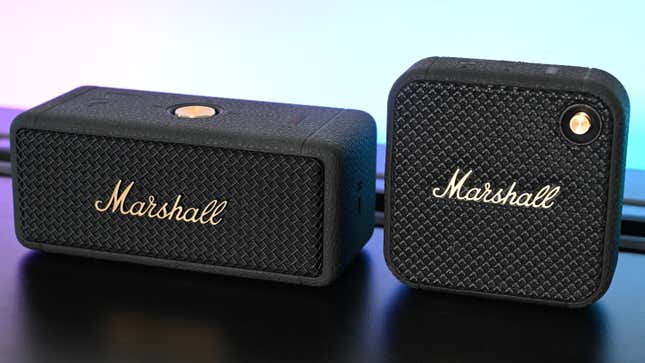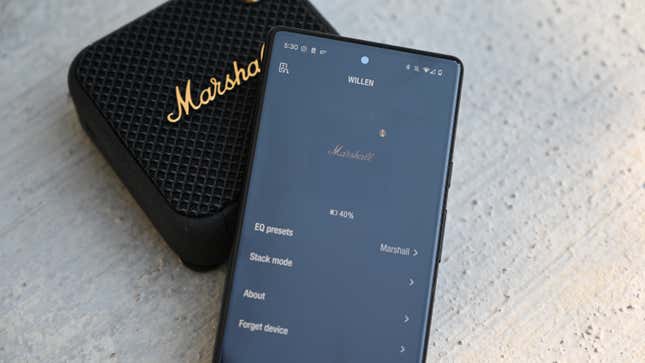
Finding the best Bluetooth speaker is like picking the right major in college. Unless you have an idea going in–in this case, brand preference–there isn’t enough time or money to try them all. So when Marshall–a premium audio brand coveted by musicians and music lovers alike–released the Emberton, a portable Bluetooth speaker, I couldn’t resist. The compact speaker has been my faithful companion up until a few weeks ago, when Marshall sent me review units of its newest speakers, the Emberton II. I also got my hands on the Willen, an even more portable newcomer.
I’ll compare the two models to help you decide which, if either, is right for your needs. What I’ll say from the start is that Marshall’s audio tuning prowess is on full display here, as both speakers pack a serious punch for their size. You also get the iconic Marshall aesthetic, complete with brass accents and faux leather, and new to this pair is a handy multi-speaker feature for stereo sound.
While these might not be the most feature-filled or sonically powerful options for the money, the Willen and Emberton II are top-tier speakers for those wanting portable wireless sound.

Marshall Willen and Emberton II price
Marshall’s twins are premium products and priced as such. The smaller Willen goes for $119, while the larger, more powerful Emberton II costs $169. The letter, I should note, is $20 more expensive than the previous version.
Iconic design, miniaturized
In a sea of bland, awkwardly shaped Bluetooth speakers, the Marshall Emberton II and Willen are a refreshingly classy duo. Musicians who have used Marshall’s amps and cabinets will grin at the familiar design elements. A copper Marshall logo in the classic cursive font is featured prominently in the center of a black grille.

The new gold-on-black scheme looks luxurious but I rather miss the contrasting white lettering and silver grille on the original Emberton. Either way, these are some of the best-looking Bluetooth speakers on the market. And that design is aided by a new rubberized leather-inspired exterior shell that looks and feels great.
Size should be a major factor when choosing between these two speakers. The cuboid-shaped Emberton II is compact but rather hefty, measuring 6.3 x 3 x 2.7 inches and weighing 1.5 pounds. For comparison, the diminutive Willen is only 4 x 4 x 1.6 inches and weighs 0.68 ounces. Those are the numbers. In the hand, the Emberton II feels dense whereas the Willen is something I could easily transport on a flight for listening in a hotel room. Both speakers are IP67 water-resistant, so don’t worry about accidental splashes or a bit of rain.
Intuitive controls
Apart from shape, one difference in design between the Emberton and Willen is the size and location of their respective control knobs. On top of the Emberton II is a circular D-pad that lets you change controls by pushing down on the top, bottom, or sides. The smaller Willen uses a front-facing thumb stick that you nudge instead of press. Both are functional and provide great tactile feedback; however, the tiny knob on the Willen can be a bit tricky to flick since it’s flush with the front of the speaker.

Using these control knobs to adjust volume and playback is intuitive. Pressing and holding the button for a few seconds turns the speakers on and off (I’d prefer a quick press from a dedicated power button, but oh well). Flick up for louder, down for quieter, left to replay the current track, left twice for the previous track, or right for the next track. A quick press plays and pauses tracks. On top of these speakers is a pleasing battery indicator with red LEDs and a circular Bluetooth pairing button.
Willen wins on features
For whatever reason, the Willen has a microphone while the larger Emberton II does not, meaning you only take calls on the smaller, less expensive model. This seems like an unnecessary omission given the extra room in the Emberton II. Perhaps Marshall feels the Willen can act as a conference call system for use in the office or at a WeWork. Still, I’d argue speakerphone functionality is just as important on the Emberton II given that this larger model makes for a good computer speaker for remote workers.

Another neat feature found only on the Willen is a rubber mounting strap on the rear. Pulling one end out and up detaches it from the speaker so you can slip the band through a backpack strap or bike handle. The strap is small and only so flexible, so you’ll have trouble fastening the speaker to wider surfaces.
Emberton II takes the sound crown
The Emberton II and Willen deliver powerful, room-filling sound for their respective sizes. Pumping sound through dual two-inch full-range drivers and two passive radiators, the Emberton II has a rich, full-bodied soundstage with a decent low-end and surprisingly crisp treble.
As expected, the Emberton II is the sonic champ. It outperforms the Willen across the entire sound signature, digging deeper on the low end and providing a smoother, more balanced midrange and treble. The Willen, to be clear, is an impressive speaker for its size, but the compromised low end means certain genres lack punch.

On bass-heavy tracks like Jessie Reyez’s “FRAUD,” the Emberton II brought a weighty thud to the low end. By comparison, the bass on the Willen sounded like the knock of a wood block. While the bass is lacking on the Willen, the Emberton II somewhat obscures the midrange, resulting in a more bloated sound. It’s subtle, and overall, this track sounded great on the larger model.
Switching to a pared-down tune predictably deemphasized the sonic differences between these two speakers. When listening to James Vincent McMorrow’s “Cavalier,” the Willen held its own, effortlessly playing this treble-heavy indie track with precise clarity and sharpness. Without the low end causing disruptions, the Emberton II did an equally excellent job, providing more balance but less vocal emphasis than the smaller sibling.

Rock, EDM, and hip-hop are simply more enjoyable on the Emberton II. The Willen punches above its size but these genres reveal the limitations of its single two-inch driver and dual passive radiators. The Killers’ “Mr. Brightside” is a great test for any speaker given the cacophony of electric tones that overlap Brandon Flowers’ smooth vocals. On the Willen, drum hits were sharp and splashy while the cymbal clashes were thin and frail.

That said, the vocals were clear and present and the guitar twangs didn’t devolve into a crowded mess as they do on laptop speakers. Here is where having an additional speaker helps the Emberton II provide a more balanced, full soundstage. Again, the Emberton favors a darker, girthier tone, but not to the point where the vocals and higher frequencies were drowned out.
Sound quality doesn’t degrade at low volume levels on either speaker, making these appropriate for nearby listening or playing more relaxed background music.
Stack Mode and battery life
When it’s time to start dancing, multiple Willen and Emberton II speakers can be paired together for a more immersive sound. Marshall calls this “Stack Mode” and it is initialized by pressing the Bluetooth button three times on the first speaker and twice on the connecting speaker. I connected the Willen to the Emberton II on the first attempt, and the twins joined forces for a pleasant stereo sound.

The Emberton II and Willen support Bluetooth 5.1 and the SBC codec, but not the AAC or AptX found on modern iPhones and Android phones. Connectivity was strong–I didn’t encounter any dropouts even with the speakers opposite the playback device in my 1,000-square-foot rental.
The Marshall Bluetooth app (available on iOS and Android) is simple and easy to use. Pairing the speakers was a breeze: just turn them on, open the app, and follow the on-screen prompts. Once paired, the speakers get access to over-the-air updates, basic EQ presets (Marshall, Push, Voice), and a guide on how to use Stack Mode.

The battery life for both models is excellent. The Willen lasts for an estimated 15 hours on a charge which is three hours longer than the JBL Flip 6. The Bose SoundLink Micro lasts for only six hours while the SoundLink Flex gets 12 hours. These are only estimates though, and your mileage will vary based on volume levels. The Emberton II gets 30 hours of battery life, 10 more than the previous model and twice that of the UE Boom 3.
Should you buy the Emberton II and Willen?
Having enjoyed owning the original Emberton, I have no hesitation recommending the upgraded model, which brings improved battery life, the ability to connect multiple speakers, and app support for adjusting settings. The Emberton II is a handsome, well-built Bluetooth speaker with a compact design and powerful balanced sound quality.
I do wish Marshall–of all companies–had included a 3.5mm jack for wired playback, and the lack of a mic on this model–but not the Willen–is a headscratcher. It’s also missing some of the latest standards for playing high-res files. And then there is the price–at $169, the Willen II has some serious competition, like the Bose SoundLink Flex and Ultimate Ears Boom 3.

If you need an ultra-portable speaker for taking on flights, strapping to your backpack, or mounting to your bike, the small Willen is a good choice. But before committing, I recommend–if you can–comparing it to the Bose SoundLink Color II, even if that alternative doesn’t last as long on a charge.
Overall, the Emberton II and Willen are capable portable Bluetooth speakers with standout designs, powerful sound for their class, and several useful features, including the ability to pair multiple units for stereo listening. Yes, they are priced above their closest competitors, but what you pay extra in cash is gained in class.